
Dugout canoes on the Sepik River. (1226k)
The Sepik river is the longest river in Papua New Guinea (PNG). It is a major transportation route.
I flew from Port Moresby to Wewak in the morning. In Wewak I walked around town a bit. I stayed in the Wewak Boutique Hotel; it was very nice, clean, good food, electricity, and cold beer. This was one of the best accommodations during the trip.
We drove about 3 hours from Wewak to Pagwi on the Sepik River, where I boarded a motorized dugout canoe. The canoe took about 1½ hours to Ambunti, where I stayed for two nights to see the Crocodile Festival. My canoe had a nice wicker chair for my comfort. I had been warned to bring an inflatable pillow to sit on for the canoe rides. I didn't use it on the first 1½ hour trip, and felt the pain. On the other rides I used the pillow, it was great after that. My guide owns the small local guest lodge in Ambunti. It was quite comfortable, the food was good. There was a shower and a regular flushing toilet. Electricity was provided by a generator that ran for a few hours in the afternoon/evening. They did have beer in the lodge. Since the generator was running in the afternoon, it was mostly chilled. On the second night there was a bit of a problem, since they had seven more guests from Italy, in addition to me and the other guy who was already there. They wanted me to share a room, which I refused, I didn't want to sleep in a shared room. They finally figured out the necessary arrangements, and all worked out OK. The only real problem was getting access to the bathrooms and showers with nine people waiting for access.
After the Crocodile Festival we took the canoe for 4½ hours down-river past Pagwi to Kamanimbit, where we stayed for one night in a local village. They had just caught a crocodile, so I had crocodile for dinner. Cooking was in clay bowls in the straw covered, wooden guest house. Apparently it doesn't go up in flames. It was quite a smoky affair.
All the houses are on stilts at least 2.5 m (8.2 ft) high. This is necessary, since the river rises considerably during the rainy season. It has the added benefit of keeping mosquitoes away, they stay around ground lever, they don't go that high. The roofs are made of palm leaves. They last about 10 - 12 years.
The villagers grow their vegetables, potatoes, bananas. They don't have rice or animals, only what they can hunt. They can catch crocodiles during the dry season in the swamps. In the rainy season they can't catch them. The dry season has the further advantage that there are not many mosquitoes around. It must be pretty bad during the rainy season.
This guest house was very basic. The toilet was a free fall hole in a board. The shower was just a bag. It didn't have water in it and I didn't bother to ask for water, I could wait another day. You have to be able to wing it in situations like that. Altogether it was an interesting experience, I had now problem living with very basic facilities.
The night was a bit noise, the roosters were going on all night. When the rooster calmed down, the dogs started barking. It was quite a cacophony.
The village has about 700 people living in it. The population seems to be decreasing, as some people, especially younger ones, leave for the cities.
The next morning we visited the local Spirit House in the village, The Spirit Houses are important for the local people, they are the centers of village life. Only men can enter the Spirit Houses. They contain beautifully painted and carved spiritual figures, drums, etc. They are used for rituals and initiations. The Spirit Houses are still important, even though the people are mostly catholic. The drums used to be used for communications. Some of the older people still seem to know about that.
After the walk through the village we started the return trip up river. On the way to Pagwi we visited two more villages, Kanganamun and Palimbe, with their Spirit Houses. In Kanganamun they did a Spirit Dance for me, it was quite impressive.
The next night I spent in Pagwi, waiting for the return drive the next morning to Wewak. The facilities in the Sanga Guest House there were also very basic, with an outhouse and no shower. The managed to get me a bucket full of water to improvise a shower. I had to fight for a single room again, they again wanted to put me together with somebody else. They didn't have electricity most of the time. They did have beer, but it was warm.
The next morning we drove back to Wewak, for another night in the Wewak Boutique Hotel, before flying back to Port Moresby.
All pictures are © Dr. Günther Eichhorn, unless otherwise noted.


























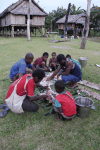



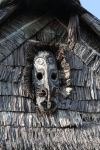
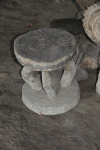

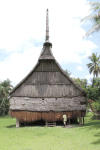
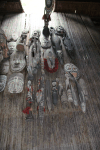



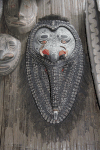
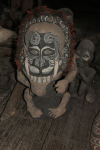
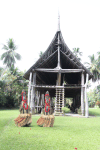
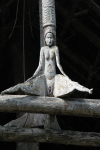
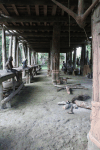


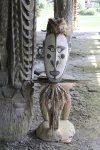
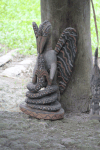
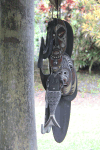
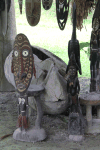
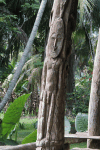
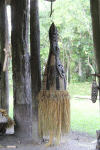
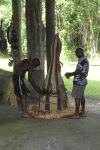
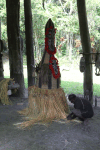



This page contains 56 pictures

Main page for Papua New Guinea
Page last updated on Tue Sep 24 18:19:03 2019 (Mountain Standard Time)
Sepik River on gei.guenther-eichhorn.com